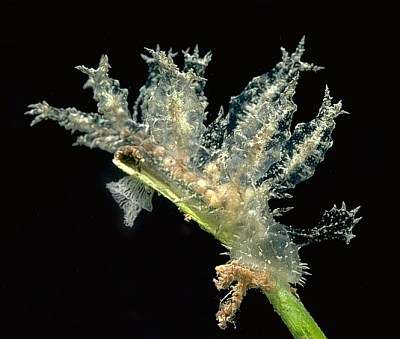
Melibe engeli
Risbec, 1937
Order: NUDIBRANCHIA
Suborder: DENDRONOTINA
Family: Tethydidae
DISTRIBUTION
Reported from New Caledonia but probably has a much wider distribution.
PHOTO
Koumac Beach (=Baie de Ouanap), near Koumac, New Caledonia, 20°34'S, 164°16'E, Mixed soft and hard substrate, grassbeds, algae, 22 October 1993, many, 43-54mm long alive. UPPER: lateral view of animal crawling down sea grass blade. Note egg mass at top. LOWER LEFT: upper view of oral hood showing greatly elaborated right rhinophore stalk and small rhinophore club (arrowed). LOWER RIGHT: 'shrimp's eye' view of oral hood about to drop down and capture its prey. Note double row of sensory papillae around edge of hood. The 'mouth' is arrowed. PHOTOS: Bill Rudman.
This can be identified with M. engeli, which has not been re-examined since Risbec's accounts. The transparent body, almost cylindrical cerata, abruptly truncated at the tip fits Risbec's description. This species is small, 50mm in Risbec's account, but both Risbec's and my observations of egg-laying show that it is not a juvenile of one of the larger species of the genus. The blunt ceratal tip is usually decorated with four or five long tapering papillae and there is a rounded flat blade on the posterior side of the rhinophore sheath, papillate along its edge. Brown zooxanthellae are scattered throughout the body. It can swim by lateral flexion of the body, and readily fed on small crustacea, both crabs and shrimps, when they were put into the aquaria. This species has only been recorded from New Caledonia.
Species of Melibe feed on shrimps, crabs and other small crustacea which they catch by waving the inflated oral hood over the substrate like a metal detector. When the sensory papillae touch a crustacean the hood rapidly closes, trapping the prey inside where it is gradually manipulayed back to the 'mouth'. Species of Melibe lack a radula, prey remaining alive in the gut until killed by digestive juices.
Reference:
• Risbec, J. (1937). Note préliminaire au sujet de nudibranches Néo-Calédoniens. Bulletin Muséum National d'Histoire Naturelle Paris, series 2,9: 159-164.
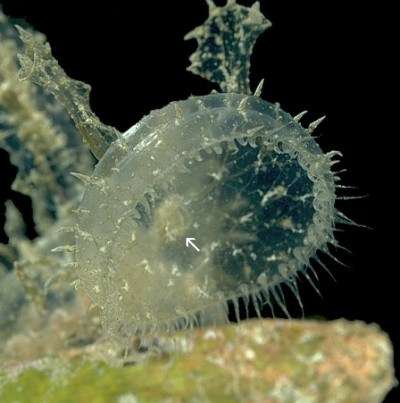
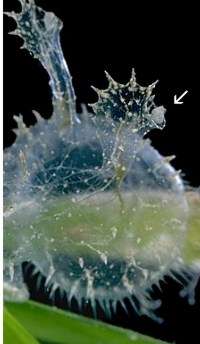
Rudman, W.B., 2000 (March 2) Melibe engeli Risbec, 1937. [In] Sea Slug Forum. Australian Museum, Sydney. Available from http://www.seaslugforum.net/find/melienge
Related messages
Melibe engeli and its oral hood
October 27, 2008
From: Charles Raabe
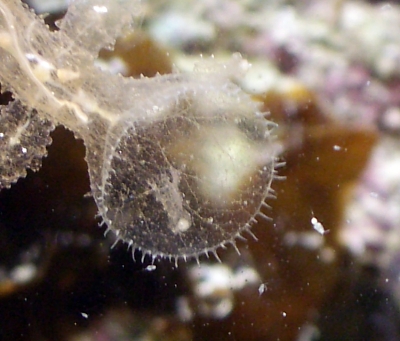
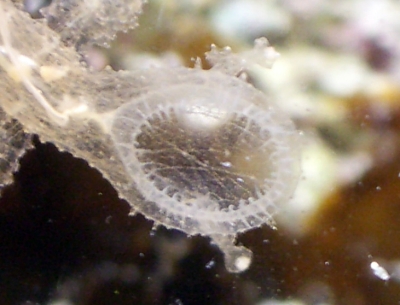
Just wanted to share this Melibe feeding sequence.
Locality: Mactan Island, 4 feet, Philippines, Camotes Sea, 03 August 2006, Reef flat. Length: One Inch . Photographer: Charles Raabe.
Charles Raabe
charlesr1958@pacific.net.ph
Raabe, C., 2008 (Oct 27) Melibe engeli and its oral hood. [Message in] Sea Slug Forum. Australian Museum, Sydney. Available from http://www.seaslugforum.net/find/17394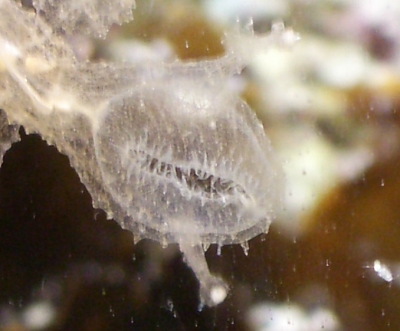
Dear Charles,
Thanks for the photos. I suspect your animal is Melibe engeli. Is this animal in an aquarium? I am trying to work out why it is opening and closing its oral hood like this, as though its catching things in the water. Although Melibe leonina from the west coast of Nth America does that [see message #15431], the other species all seem to 'feel' for bottom dwelling animals as they crawl along. Perhaps yours is crawling upside down on the water surface feeling for debris floating there?
Best wishes,
Bill Rudman
Melibe engeli - aquarium hitchhiker
May 2, 2008
From: Can Tunali
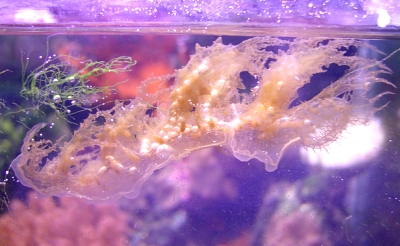
Concerning message #21447:
Dear Bill ,
These are from my refugium . I get my live rock from the local suppliers . They bring the live rocks from Maleysia , Indonesia or Singapore .
I noticed them first on 14 February 2008 as the shape in the lower photo.
The largest and the oldest one still alive and around 15 cm [upper photo]. They are laying eggs on the glass every 4 days.
Regards
Can Tunali
Aquarist
Cairo, Egypt
vip_34@hotmail.com
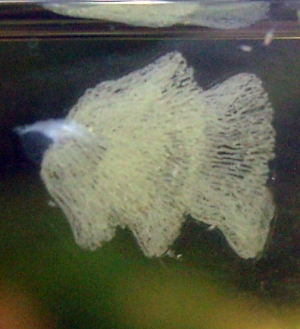
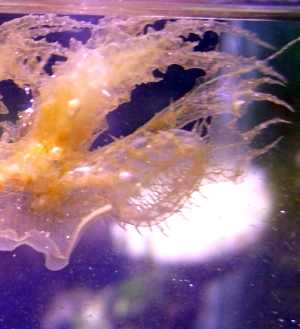
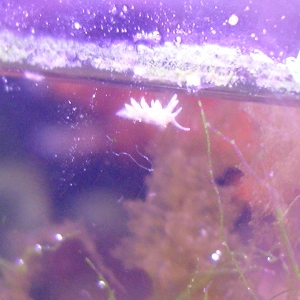
Dear Can,
The big animal laying eggs in you aquarium is a species of Melibe, almost certainly Melibe engeli. These amazing nudibranchs feed on small crustacea (shimps, prawns, crabs etc) by catching them in their large oral which acts like a fishing net. Have a look at the species' Fact Sheet and attached messages for more information. Also have a look at the other species of Melibe and Tethys on the Forum for more background information. You could possibly keep them alive by adding a few brine shrimp to the water but I am not sure if they would be able to capture swimimg prey.
The small white nudibranch [photo alongside] which you thought was a juvenile is a quite different nudibranch. It is an aeolid and probably doesn't grow much bigger. It will feed on some type of cnidarian, perhaps a hydroid or soft coral, but without a lot more information I can't say much more.
Best wishes,
Bill Rudman
Giant-mouthed shrimp-eating sea slug
November 14, 2007
From: Katie LeFevre
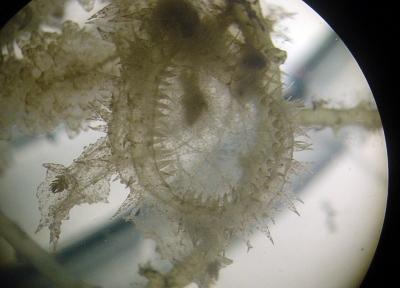
October 10, 2007
During a nighttime excursion, this little guy (~2 inches) "swam" (by turning on its side and bending back and forth) up in the water column after its large (2ft tall) clump of algae was moved around (we were looking for other things inside it). The area is a very calm intertidal zone (boat dock bay area), we were there at low tide and so the slug was about 1-2 feet underwater.
I've never seen one like before so I was able to take him back to our lab and get some close up photos under a scope before we took him back.
Locality: Kaneohe Bay Boat Docks, 2 feet, Oahu, HI, USA, Indo-Pacific, 10 October 2007, Sludgy/sandy Calm Intertidal. Length: 2 inches. Photographer: Katie LeFevre.
What struck me first as unique was his mouth... which made me think of a little kid's worst nightmare. It's wider than any other part of his body and he crawls around with it open. As he crawled along the algae, he would randomly put his mouth around an branch of it and close tightly. Then you could see a "throat" area just behind his mouth flex -- like it was swallowing. The inner 'tentacles' of his mouth ring could move independent of each other and seemed to be tasting the area. AND at one point I could have sworn I saw an amphipod struggling in his mouth.
Very curious now, I put a tiny mysis shrimp chunk in front of him and to my surprise, he closed his around it "grabbed" it with his "throat" and didn't open his mouth until it was engulfed inside him.
Is there a certain group of slugs that eat other things than coral/sponges?? There are lots of sponges in the area, yet.. he ate the shrimp?
His body was detailed, you can see the lattice patterns in his skin. He had 5-6 big, bulbous cerata that were randomly spaced, but actually were shed when he was bothered (noticed one of that when I poured him into a viewing dish) and that could be the cause of spacing. The translucence and spiked texture made him blend in with all the algae perfectly like a piece of sludge.
Previously found in the same area was a Polybranchia orientalis --which also exhibited cerata shedding behavior.
The attatched pictures show his head, eyes and "throat" (dark area in middle of mouth), mouth closed around algae (there's a baby swimming-anemone right in front of him), and his tail end.
I hope you can at least give me a lead on what group of slugs he belongs to, or how I might identify him.
Mahalo,
Katie LeFevre
Brigham Young University-Hawaii
Marine Lab Manager
craz4myhorse@hotmail.com
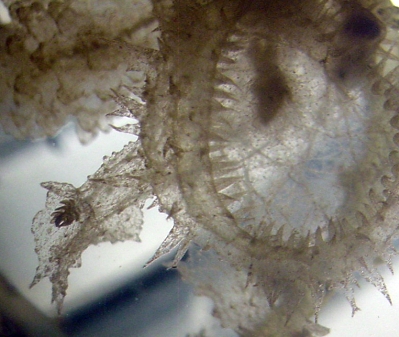
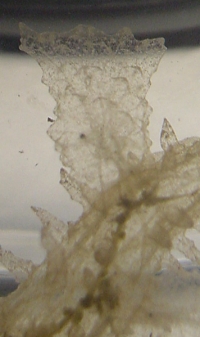
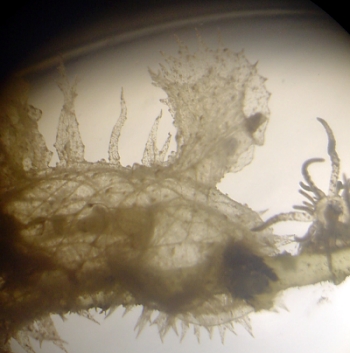
Dear Katie,
'Giant-mouthed shrimp-eating sea slug' - now that's a descriptive name which well descibes this fascinating animal. It is Melibe engeli, one of a group of species which have lost their teeth - and all the associated structures - and feeds on small crustacea by using their fishing-net like mouth to 'feel' out prey and scoop them up. Have a look at the Fact Sheet for this species and associated messages for further information.
Dropping body parts, as you describe for this animal, is a defensive technique used by quite a number of unrelated opisthobranchs [see Autotomy page]. It's usually accompanied by sticky glandular secretions which cause the 'spare part' to stick to a predator's mouth long enough to distract it from eating the rest of the slug.
Best wishes,
Bill Rudman
More on Melibe engeli
July 5, 2007
From: Jung Eun Yoon
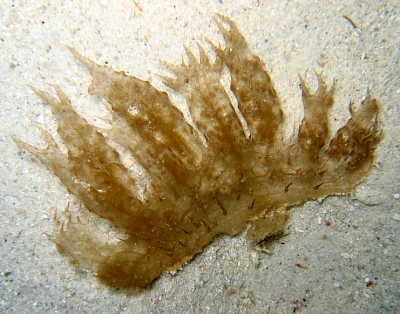
Dr, Rudman,
As a follow up on our last message [#19762] we found Melibe engeli? again during a night dive, and I am sending you pictures of its details. You can clearly see that the cerata have up to 6 papillae, and that the rhinophores are large and flat, with papillae. It is more than 8 cm long, can it be a different sub-species of M. engeli? It was feeding on algae, but when disturbed by light, it hid its hood under the algae. Is it a normal behavior? Many thanks for your kind attention.
Locality: Boracay Island, 3 meters, Philippines, Sulu Sea, 24 March 2007, Sand temporarily covered with algae. Length: more than 8 cm. Photographer: Yeong Jeon.
Jung Eun Yoon
jungeuny@hotmail.com
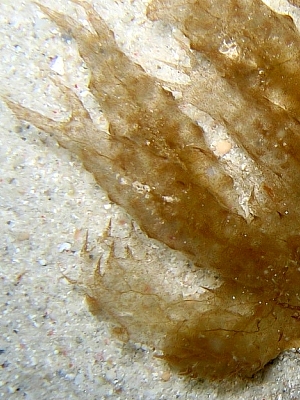
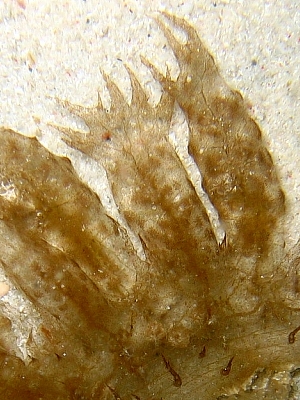
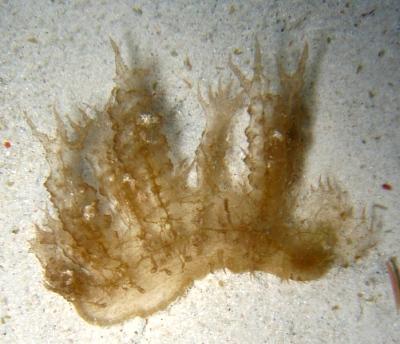
Dear Jung Eun,
Thanks for the extra photos. Your animals are certainly larger than I have seen before but lots of the observations to the Forum show us that what is printed is not always the full story. It seems that M. engeli grows larger than previously thought. You say it was 'it was feeding on algae'.. I am not sure if you mean it seemed to be eating algae or that it was feeding on animals living on algae. All I can say is I am sure it doesn't eat algae. I have spent many hours watching Melibe engeli catching small crustacea in its oral hood and swallowing them whole. It has lost its jaws and radular teeth so it has evolved this very specialised feeding behaviour. It has no equipment to bite or rip off a piece of algae to eat.
I am not sure how to interpret your observation of it hiding its oral hood under the algae when you shone a light on it. It may have been trying to unsuccessfully hide itself from a potential predator but that's just a guess.
Best wishes,
Bill Rudman
Melibe engeli from the Philippines
May 25, 2007
From: Jung Eun Yoon
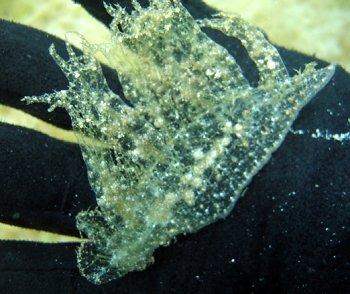
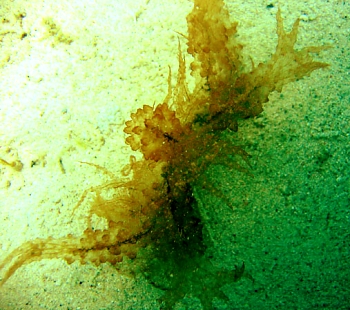
Dr. Rudman,
I found this Melibe engeli in Boracay, Philippines, can you confirm its identity from the pictures? The body was about 8 cm long, was transparent through which I could see a few dark balls (suppose they were zooxanthellae), swam vigorously by laterally flexing the body. Even when I put it on the hand, it moved so fast that it was difficult to take a good picture. Nearby were found two egg masses which were dextral.
In the same area we also found 2 Melibe viridis, and another egg mass which was completely opaque. Species of Melibe are rare and only seasonal. Nowadays the sandy bottom is covered with algae. The Melibe viridis was on the algae but the Melibe engeli was on a rock. I am sorry I cannot provide any details about its rhinophore.
Locality: Boracay island, 3.5 m, Philippines, Sulu Sea, 23 March 2007, Sandy bottom with rocks. Length: 8 cm. Photographer: Yeong Jeon.
jungeuny@hotmail.com
Yoon, J.E., 2007 (May 25) Melibe engeli from the Philippines. [Message in] Sea Slug Forum. Australian Museum, Sydney. Available from http://www.seaslugforum.net/find/19762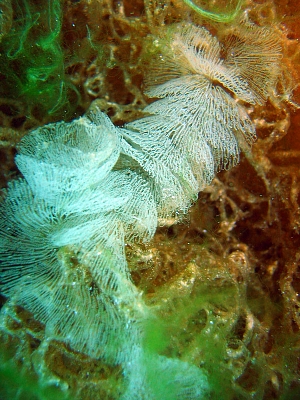
Dear Jung Eun,
I agree that this is most probably M engeli. It looks a bit like M. bucephala but in that species the cerata are quite elongated, as are the papillae at the end of the cerata.
I assume the egg mass alongside was one of those found with Melibe viridis? It is a bit big for the M. engeli. It is nice to get a good photo.
Best wishes,
Bill Rudman
Melibe with eggs from East Timor
December 7, 2006
From: Brian Francisco
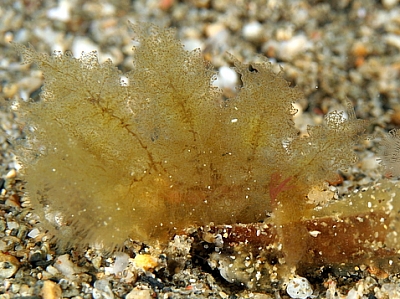
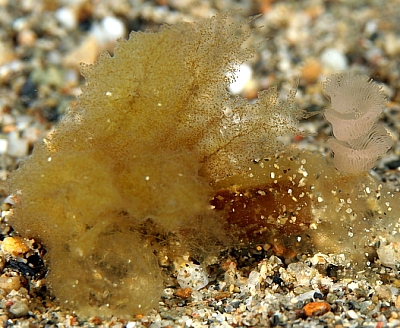
Bill
Attached are a few photos of a Melibe having just laid a small spiral of eggs. This is one of about ten individuals encountered last night, not clustered together, but over a large sandy area.
Locality: Sandy Bottom, 13 meters, East Timor, Banda Sea, 30 November 2006, sandy slope. Length: 3 cm. Photographer: Brian Francisco.
Brian
francisco.brian@gmail.com
Francisco, B., 2006 (Dec 7) Melibe with eggs from East Timor. [Message in] Sea Slug Forum. Australian Museum, Sydney. Available from http://www.seaslugforum.net/find/18829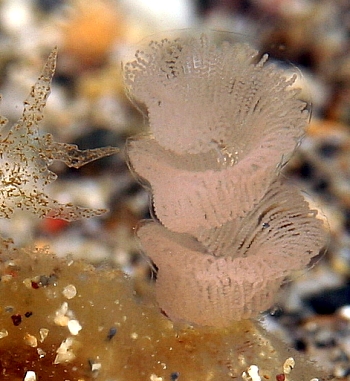
Dear Brian,
Thanks for these photos of Melibe engeli. Of great interest to me is that the egg ribbon is identical in shape to one I photographed in New Caledonia of this species [message #9356], even to the dextral coiling. It would certainly be interesting if we could find the egg ribbons of other species of Melibe to see if they were also species specific.
Best wishes,
Bill Rudman
Melibe sp? in my aquarium
February 15, 2006
From: Michael Biester
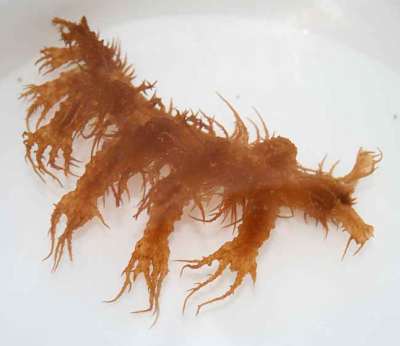
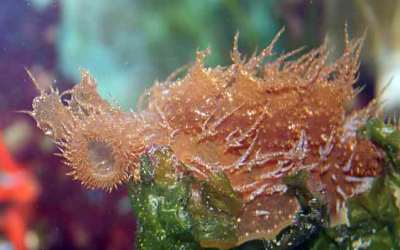
Hello,
I hope you are able to help me. Today i bought this snail, it seems to be a Melibe sp.
It is most probably a Caribbean sp, able to swim and seems to feed on plankton, Its present length is 10 cm.
Are you able to identify it and give me information on how to keep it?
Many thanks in advance
Michael
m.biester@web.de
Biester, M., 2006 (Feb 15) Melibe sp? in my aquarium. [Message in] Sea Slug Forum. Australian Museum, Sydney. Available from http://www.seaslugforum.net/find/15823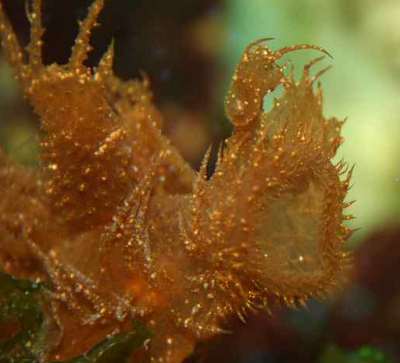
Dear mbb,
This is indeed a species of Melibe but I suspect it is from somewhere in the Indian or Pacific oceans. It look quite like Melibe engeli but I wonder if it is a bit too 'hairy' for that species.
Concerning feeding. Species of Melibe use their large oral hood as a sort of fishing net to catch and eat small shrimps, crabs and other crustacea. I think most aquarium shops stock the eggs of the Brine Shrimp [Artemia]. If you tried feeding it Brine Shrimp larvae or even adults, I am sure it would be grateful. I am not sure how long it is likely to live in your aquarium as most nudibranchs live only for a few months, but if you can get it to eat Artemia at least it will die of old age rather than starvation.
Best wishes,
Bill Rudman
Re: Hitch-hiking Melibe engeli
February 1, 2004
From: Todd Gardner
Concerning Hitch-hiking Melibe engeli. Does this species have a pelagic larval stage? I'm wondering what it's chances are of successful reproduction in a coral tank.
Todd Gardner
fishtail22@aol.com
Gardner, T., 2004 (Feb 1) Re: Hitch-hiking Melibe engeli. [Message in] Sea Slug Forum. Australian Museum, Sydney. Available from http://www.seaslugforum.net/find/12069Dear Todd,
From the small size of its eggs [see my earlier message] I would suspect it has planktonic larvae which would make tank breeding pretty difficult even if you had a couple of adults to start with. However since it will feed happily on Artemia nauplii it would be a much more practical nudibranch to keep in an aquarium than a sponge, hydroid or bryozoan-feeder.
Cheers
Bill Rudman
Hitch-hiking Melibe engeli
January 30, 2004
From: Joe Yaiullo
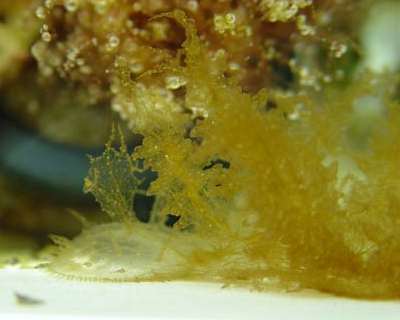
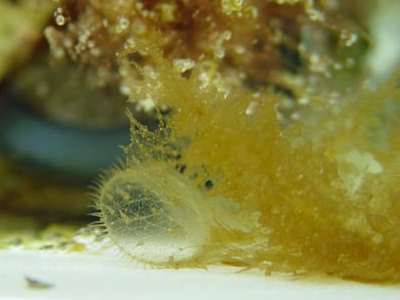
Dear Dr. Rudman,
We came across this nudibranch in one of our coral propagation troughs today. All live rock came from the Pacific. Do you know what species it is? It readily eats Artemia nauplii and would scrape the tank walls with its large "mouth". I have attached 3 photos.
Thank you,
Joe Yaiullo
justjoe63@aol.com
Yaiullo, J., 2004 (Jan 30) Hitch-hiking Melibe engeli. [Message in] Sea Slug Forum. Australian Museum, Sydney. Available from http://www.seaslugforum.net/find/12054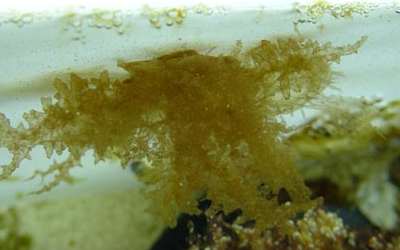
Dear Joe,
If you find very strange animals interesting, then you have hot the jackpot here. This is Melibe engeli. Like all the members of its family it feeds on small crustacea which it catches in its enormous 'oral hood'. If you look at the species' Fact Sheet it should give you some background information.
We know very little about the life cycles of these animals but as long as you don't mind losing a few nauplii, I am sure it will live quite happily in your coral propagation troughs without interfering
Best wishes
Bill Rudman
Melibe engeli - dextral egg spiral
March 6, 2003
From: Bill Rudman
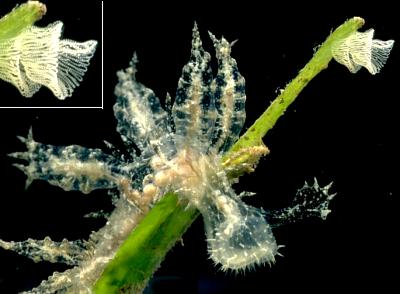
After thinking about Irina Roginskaya's message on the dextral coiling of the egg ribbon of Melibe australis, I wondered if perhaps the direction of egg coiling was related to evolutionary descent rather than which hemisphere the species lived in. The only other record of a Melibe egg mass I could think of was this one of Melibe engeli which I had photographed in New Caledonia.
Photo: Koumac Beach (=Baie de Ouanap), near Koumac, New Caledonia, 20°34'S, 164°16'E, 22 October 1993, many animals 43-54mm long alive. Photos: Bill Rudman.
A photo of this egg mass has been on the species Fact Sheet for some years, but we have overlooked that it is also dextral. Although dextral egg masses in two species of Melibe from the southern hemisphere can't really be said to prove anything, it would certainly be interesting to see photos of the egg ribbons of other species of Melibe. If anyone has any, please check carefully when scanning that the slide is not reversed.
Best wishes,
Bill Rudman
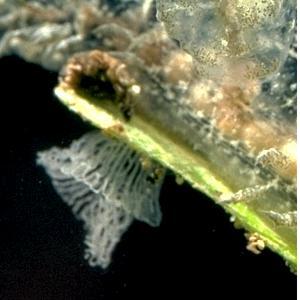
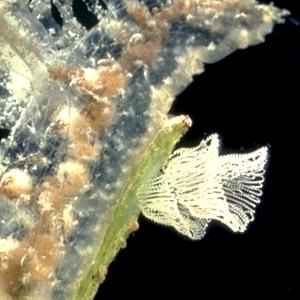
Melibe engeli in aquarium
January 28, 2002
From: Andrew Trevor-Jones
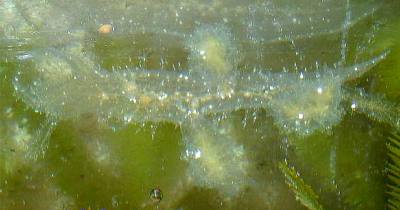
Bill,
You may be interested in some pictures of a Melibe sp. I found in one of my tanks. This must have arrived on "live rock" [from tropical Australia?] some six months earlier and somehow survived in the tank for all that time. Unfortunately, the tank crashed in April, 2000 about a month after I took the photo and I lost it. I assume it is M. engeli.
Andrew.
atj777@attglobal.net
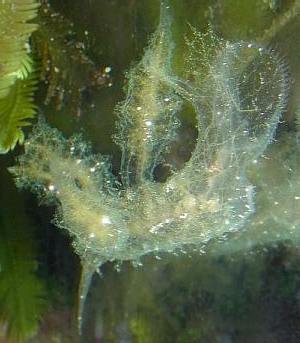
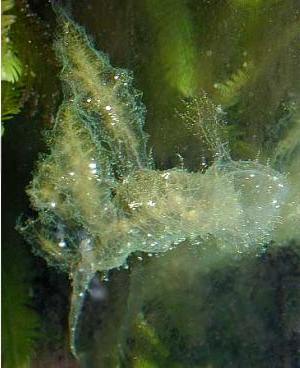
Dear Andrew,
Thanks for the photos. Certainly interesting to think that this animal could find enough small crustacea in your aquaria to not only stay alive but to grow substantially. It certainly looks like M. engeli.
Best wishes,
Bill Rudman
Melibe engeli from Japan
March 5, 2000
From: Atsushi Ono
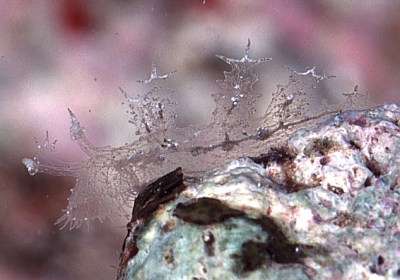
Dear Bill,
Thank you for about Halgerda sp.4.
I have the photo a juvenile of Melibe species. I have thought this was M. papillosa, but this is similar to Lindsay's animal. Could you check this animal?
Data: Kerama Is. near Okinawa, 12mm long,
Crawling on algae, 3m depth, in May, 1999.
Sincerely,
Atsushi Ono
ononini@cosmos.ne.jp
Ono, A., 2000 (Mar 5) Melibe engeli from Japan. [Message in] Sea Slug Forum. Australian Museum, Sydney. Available from http://www.seaslugforum.net/find/2036Dear Atsushi,
I am pretty sure this is Melibe engeli. If you look at the shape of the rhinophore stalk, with its papillate wing, it si identical to your animal. The tip of the cerata have three papillae but they look more flattened in your animal. This seems to be caused by the outer papillae lying out sideways.
Looking at your animal I think, as Terry Gosliner suggested, that Lindsay Warren's animal is M. engeli though it would be useful to know what the rhinophores looked like.
Best wishes.
Bill Rudman.
Re: Melibe sp. from S.E. Sulawesi
March 3, 2000
From: Terry Gosliner
Dear Bill,
Lindsay Warren's Melibe photo is probably Melibe engeli Risbec. We have found numerous specimens in the Philippines and Hawaii. My graduate student, Vic Smith and I are completing a review of Melibe with a re-description of M. engeli and several other Indo-Pacific species, including three new species.
Terry.
tgosline@calacademy.org
Gosliner, T., 2000 (Mar 3) Re: Melibe sp. from S.E. Sulawesi. [Message in] Sea Slug Forum. Australian Museum, Sydney. Available from http://www.seaslugforum.net/find/2003Dear Terry,
In response to your message I have finished a page I was preparing on Melibe engeli. I decided against M. engeli for Lindsay's photos for two reasons. Firstly the cerata in her photos is flattened across the top even though it has three papillae, while in M. engeli the tip is always pointed and the papillae clustered together. The second point is that M. engeli has a very large elaborate rhinophore stalk while in M. viridis the stalk is simple and both the stalk and rhinophore club are relatively very small. I can't see them clearly in her photo but the mention of 'simple rhinophores' suggested the M. viridis type to me.
I don't know if we know enough about the juvenile stages of the larger species to say that long terminal papillae are exclusive to certain species. Perhaps juvenile M. viridis have ceratal papillae in juveniles which are absent in adults. Perhaps Lindsay can give us an idea about the rhinophores now there are a couple of species on the Forum for comparison.
I look forward to your next revision of Melibe
Cheers,
Bill Rudman.
Melibe from SE Sulawesi
February 29, 2000
From: Lindsay Warren
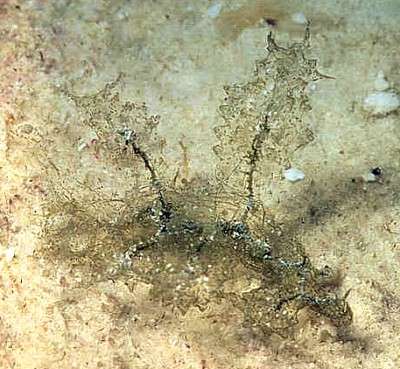
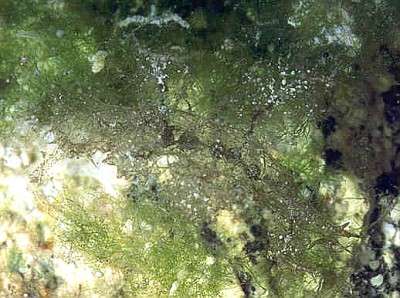
Dear Bill
I found this heavily disguised Melibe at approximately 8pm on 2 November 1999 at a depth of 5 ft on a batch of dark red filamentous algae on the sand and seagrass flats of Pulau Hoga [Tukang Besi Archipelago, SE Sulawesi, Indonesia - Operation Wallacea]. Size: 20 mm.
It is transparent with flecks of dark green and white and through the body one can see its internal organs. The oral veil is relatively small but just visible in these two shots. Along both sides of the body are 2 long papillate cerata which terminate in 2-3 'spiky' extensions. The rhinophores are simple and transparent. A very curious specimen which I almost lost in our aquarium because it blends in so well with its
surroundings. There were also a lot of small Stylocheilus striata (5-10mm) in the same patch of algae. Photos: Lindsay Warren.
Can you identify the species?
All the best
Lindsay Warren
100014.2112@compuserve.com
Warren, L., 2000 (Feb 29) Melibe from SE Sulawesi. [Message in] Sea Slug Forum. Australian Museum, Sydney. Available from http://www.seaslugforum.net/find/1966Dear Lindsay,
This is a species of Melibe, and I am pretty sure it is a juvenile Melibe viridis. M. viridis is the only species with such a flattened top to the 'tip' of its ceratal processes. Most 'species' are incredibly well camouflaged, and even when they are much larger the transparency is replaced with a mottled pattern of camouflage colours. Identifying species is quite difficult because they have no radula.
Best wishes,
Bill Rudman.
